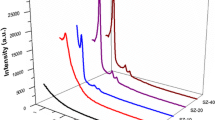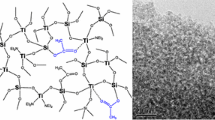Abstract
A novel non-hydrolytic sol–gel (NHSG) synthesis of mesoporous zirconium silicate xerogels is presented. The condensation between silicon acetate, Si(OAc)4, and Zr(NEt2)4 resulting in acetamide elimination leads to homogeneous zirconium silicate xerogels containing Si–O–Zr linkages. The addition of Pluronic P123 template provides stiff gels that are after template removal by calcination at 500 °C in air converted to stable mesoporous xerogels with wormhole-type pores, high surface area over 500 m2 g−1, and tetrahedrally coordinated Zr atoms in the framework. The composition and morphology of the xerogels, volatile reaction byproducts, and thermal transformations were followed by elemental analysis, IR spectroscopy, thermal analysis TG-DSC, nitrogen adsorption, 13C and 29Si solid-state NMR spectroscopy, DRUV–Vis spectroscopy, SAXS, and HT powder XRD. These potential catalysts were tested for the Meerwein–Ponndorf–Verley reduction of 4-tert-butylcyclohexanone and for aminolysis of styrene oxide with aniline. Resulting reaction systems display good activity and selectivity.














Similar content being viewed by others
References
Rodríguez Avendaño RG, De Los Reyes JA, Viveros T, Montoya De La Fuente JA (2009) Synthesis and characterization of mesoporous materials: silica–zirconia and silica–titania. Catal Today 148(1–2):12–18
Yokoyama T, Setoyama T, Fujita N, Nakajima M, Maki T, Fujii K (1992) Novel direct hydrogenation process of aromatic carboxylic acids to the corresponding aldehydes with zirconia catalyst. Appl Catal A 88(2):149–161
Bruce L, Mathews JF (1982) The Fischer–Tropsch activity of nickel–zirconia. Appl Catal 4(4):353–369
Rezaei M, Alavi SM, Sahebdelfar S, Bai P, Liu X, Yan Z-F (2008) CO2 reforming of CH4 over nanocrystalline zirconia-supported nickel catalysts. Appl Catal B 77(3–4):346–354
Jung K, Bell A (2002) Effects of zirconia phase on the synthesis of methanol over zirconia-supported copper. Catal Lett 80(1–2):63–68
Knauer B, Krohn K (1995) A reinvestigation of the Meerwein–Ponndorf–Verley reduction. A highly efficient variation using zirconium catalysts. Liebigs Annalen 4:677–683
Rakshe B, Ramaswamy V, Hegde SG, Vetrivel R, Ramaswamy AV (1997) Crystalline, microporous zirconium silicates with MFI structure. Catal Lett 45(1–2):41–50
Rakshe B, Ramaswamy V, Ramaswamy AV (1996) Crystalline, microporous zirconium silicates with MEL structure. J Catal 163(2):501–505
Dongare MK, Sabde DP, Shaikh RA, Kamble KR, Hegde SG (1999) Synthesis, characterization and catalytic properties of ZrAPO-5. Catal Today 49(1–3):267–276
Zhu Y, Chuah G, Jaenicke S (2003) Al-free Zr–zeolite beta as a regioselective catalyst in the Meerwein–Ponndorf–Verley reaction. Chem Commun 21:2734
Anwander R, Gerstberger G, Palm C, Groeger O, Engelhardt G (1998) Enhanced catalytic activity of MCM-41-grafted aluminium isopropoxide in MPV reductions. Chem Commun 17:1811–1812
Leyrit P, McGill C, Quignard Fo, Choplin A (1996) A novel heterogeneous molecular catalyst for the Meerwein–Ponndorf–Verley and Oppenauer reactions. J Mol Catal A: Chem 112(3):395–400
Quignard F, Graziani O, Choplin A (1999) Group 4 alkyl complexes as precursors of silica anchored molecular catalysts for the reduction of ketones by hydrogen transfer. Appl Catal A 182(1):29–40
Morey MS, Stucky GD, Schwarz S, Fröba M (1999) Isomorphic substitution and postsynthesis incorporation of zirconium into MCM-48 mesoporous silica. J Phys Chem B 103(12):2037–2041
Ramanathan A, Subramaniam B, Maheswari R, Hanefeld U (2013) Synthesis and characterization of Zirconium incorporated ultra large pore mesoporous silicate, Zr–KIT-6. Microporous Mesoporous Mater 167:207–212
Do DM, Jaenicke S, Chuah G-K (2012) Mesoporous Zr-SBA-15 as a green solid acid catalyst for the Prins reaction. Catal Sci Technol 2(7):1417–1424
Zhao Z, Liu Y, Wu H, Li X, He M, Wu P (2009) Hydrothermal synthesis of mesoporous zirconosilicate with enhanced textural and catalytic properties with the aid of amphiphilic organosilane. Microporous Mesoporous Mater 123(1–3):324–330
Kore R, Srivastava R, Satpati B (2013) Highly efficient nanocrystalline zirconosilicate catalysts for the aminolysis, alcoholysis, and hydroamination reactions. ACS Catal 3(12):2891–2904
Chen LH, Xu ST, Li XY, Tian G, Li Y, Rooke JC, Zhu GS, Qiu SL, Wei YX, Yang XY, Liu ZM, Su BL (2012) Multimodal Zr–Silicalite-1 zeolite nanocrystal aggregates with interconnected hierarchically micro–meso–macroporous architecture and enhanced mass transport property. J Colloid Interface Sci 377(1):368–374
Kriesel JW, Sander MS, Tilley TD (2001) Block copolymer-assisted synthesis of mesoporous, multicomponent oxides by nonhydrolytic, thermolytic decomposition of molecular precursors in nonpolar media. Chem Mater 13(10):3554–3563
Scolan E, Sanchez C (1998) Synthesis and characterization of surface-protected nanocrystalline titania particles. Chem Mater 10(10):3217–3223
Yoldas B (1986) Zirconium oxides formed by hydrolytic condensation of alkoxides and parameters that affect their morphology. J Mater Sci 21(3):1080–1086. doi:10.1007/BF01117398
Debecker DP, Mutin PH (2012) Non-hydrolytic sol–gel routes to heterogeneous catalysts. Chem Soc Rev 41(9):3624–3650
Debecker DP, Hulea V, Mutin PH (2013) Mesoporous mixed oxide catalysts via non-hydrolytic sol–gel: a review. Appl Catal A 451:192–206
Andrianainarivelo M, Corriu R, Leclercq D, Mutin PH, Vioux A (1996) Mixed oxides SiO2–ZrO2 and SiO2–TiO2 by a non-hydrolytic sol–gel route. J Mater Chem 6(10):1665–1671
Kaper H, Bouchmella K, Mutin PH, Goettmann F (2012) High-surface-area SiO2–ZrO2 mixed oxides as catalysts for the Friedel–Crafts–Type alkylation of arenes with alcohols and tandem cyclopropanation reactions. ChemCatChem 4(11):1813–1818
Jansen M, Guenther E (1995) Oxide gels and ceramics prepared by a nonhydrolytic sol–gel process. Chem Mater 7(11):2110–2114
Styskalik A, Skoda D, Pinkas J, Mathur S (2012) Non-hydrolytic synthesis of titanosilicate xerogels by acetamide elimination and their use as epoxidation catalysts. J Sol Gel Sci Technol 63(3):463–472
Goubeau J, Mundiel RZ (1953) Uber das trichlorsiliciumacetat. Z Anorg Allg Chem 272(1–4):313–326
Bradley DC, Thomas IM (1960) 765. Metallo-organic compounds containing metal–nitrogen bonds. Part I. Some dialkylamino-derivatives of titanium and zirconium. J Chem Soc (Resumed):3857–3861. doi:10.1039/JR9600003857
Rouquerol J, Rouquerol F, Llewellyn P, Maurin G, Sing KSW (2013) Adsorption by powders and porous solids: principles., Methodology and ApplicationsElsevier Science, London
Lowell S, Shields J, Thomas M, Thommes M (2004) Characterization of porous solids and powders: surface area, pore size and density, vol 16., Particle Technology Series, Springer, Netherlands
Socrates G (2007) Infrared and raman characteristic group frequencies : tables and charts. John Wiley, West Sussex
Su Y-l, Wang J, Liu H-z (2002) FTIR spectroscopic study on effects of temperature and polymer composition on the structural properties of PEO–PPO–PEO block copolymer micelles. Langmuir 18(14):5370–5374
Deacon G, Phillips R (1980) Relationships between the carbon–oxygen stretching frequencies of carboxylato complexes and the type of carboxylate coordination. Coord Chem Rev 33(3):227–250
Doeuff S, Henry M, Sanchez C, Livage J (1987) Hydrolysis of titanium alkoxides: modification of the molecular precursor by acetic acid. J Non-Cryst Solids 89(1–2):206–216
Kongwudthiti S, Praserthdam P, Tanakulrungsank W, Inoue M (2003) The influence of Si–O–Zr bonds on the crystal-growth inhibition of zirconia prepared by the glycothermal method. J Mater Proc Technol 136(1–3):186–189
Chen S-G, Yin Y-S, Wang D-P (2005) Formation of ring-like Si–O–Zr bonds at intergranular interfaces in silica-doped zirconia. J Am Ceram Soc 88(4):1041–1045
Miller JM, Lakshmi LJ (1998) Spectroscopic characterization of sol–gel-derived mixed oxides. J Phys Chem B 102(34):6465–6470
Balmer ML, Bunker BC, Wang LQ, Peden CHF, Su Y (1997) Solid-state 29Si MAS NMR study of titanosilicates. J Phys Chem B 101(45):9170–9179
Sindorf DW, Maciel GE (1982) Cross-polarization magic-angle-spinning silicon-29 nuclear magnetic resonance study of silica gel using trimethylsilane bonding as a probe of surface geometry and reactivity. J Phys Chem 86(26):5208–5219
Tanabe K (1999) Industrial application of solid acid–base catalysts. Appl Catal A 181(2):399–434
Chen S-Y, Lee J-F, Cheng S (2010) Pinacol-type rearrangement catalyzed by Zr-incorporated SBA-15. J Catal 270(1):196–205
Ramanathan A, Castro Villalobos MC, Kwakernaak C, Telalovic S, Hanefeld U (2008) Zr-TUD-1: a Lewis acidic, three-dimensional, mesoporous, zirconium-containing catalyst. Chemistry 14(3):961–972
Tanev PT, Pinnavaia TJ (1996) Mesoporous silica molecular sieves prepared by ionic and neutral surfactant templating: a comparison of physical properties. Chem Mater 8(8):2068–2079
Yang P, Zhao D, Margolese DI, Chmelka BF, Stucky GD (1999) Block copolymer templating syntheses of mesoporous metal oxides with large ordering lengths and semicrystalline framework. Chem Mater 11(10):2813–2826
Barrett EP, Joyner LG, Halenda PP (1951) The determination of pore volume and area distributions in porous substances. I. computations from nitrogen isotherms. J Am Chem Soc 73(1):373–380
Storck S, Bretinger H, Maier WF (1998) Characterization of micro- and mesoporous solids by physisorption methods and pore-size analysis. Appl Catal A 174(1–2):137–146
Tanabe K, Misono M, Ono Y, Hattori H (eds) (1989) New solid acids and bases: their catalytic properties. In: Studies in surface science and catalysis, vol 51. Elsevier
De bruyn M, Limbourg M, Denayer J, Baron GV, Parvulescu V, Grobet PJ, De Vos DE, Jacobs PA (2003) Mesoporous Zr and Hf catalysts for chemoselective MPV reductions of unsaturated ketones. Appl Catal A 254(2):189–201
Acknowledgements
Authors thank the project CEITEC—Central European Institute of Technology CZ.1.05/1.1.00/02.0068 and KONTAKT II LH11028 for the financial assistance. A.S. thanks the Brno City Municipality for Brno Ph.D. Talent Scholarship. Authors thank L. Simonikova and Dr. K. Novotny for ICP-OES analyses, L. Krauskova for DRUV-Vis spectra measurements, Dr. M. Klementova for TEM analyses, and Dr. T. Klumpler (Single Crystal X-ray Diffraction Core Facility CEITEC) for the SAXS measurements.
Author information
Authors and Affiliations
Corresponding author
Rights and permissions
About this article
Cite this article
Skoda, D., Styskalik, A., Moravec, Z. et al. Templated non-hydrolytic synthesis of mesoporous zirconium silicates and their catalytic properties. J Mater Sci 50, 3371–3382 (2015). https://doi.org/10.1007/s10853-015-8888-1
Received:
Accepted:
Published:
Issue Date:
DOI: https://doi.org/10.1007/s10853-015-8888-1




